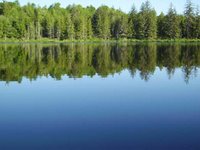
A large die-off of invasive Brazilian Elodea on Lake Leland in Quilcene, WA was recently formally noted by the Jefferson County Conservation District. Glenn Gately, Conservation District resource technician, visits the lake annually to track conditions there. During a recent visit he was surprised to see that the formerly thick Brazilian Elodea infestation had almost completely disappeared.
A call to Pamela Roberts, county 4-H coordinator, helped begin the process of gathering information that might shed light on what led to the death of the Brazilian Elodea that previously clogged the lake. Glenn knew that Pamela lived on Lake Leland and was hoping she might have observed something that could help scientists understand what had happened.
Pamela shared:

"My best recollection is that I first noticed the Brazilian Elodea turning an oily looking black at the top tips sometime around November 2005. I was curious about why it was turning black and guessed that the plant had either ended some sort of growth cycle and was dying back to reemerge in the spring or that the state Ecology staff had somehow poisoned the plants. These were guesses, of course, and were somewhat influenced by the fact that I knew scientists had been working on the lake at night on occasion. I have since been informed that they were probably doing tests with fish during these night time excursions.
After I noticed the blackening tips I started to check on the Elodea around our dock each day. It was not long before all the Elodea was completely gone. It happened within 2 days to 2 weeks - I can't be sure of the time period that it took to completely rot away, but it was a very fast process.
Where there had once been Elodea so thick that you could barely row a boat through it, there was now completely open water. The whole area around my dock was completely clear of vegetation, except for the reeds on the shoreline. This seemed strange at the time and somewhat concerning because of the radical and rapid change. My first concern was how this change might impact the annual migration of the Trumpeter Swans that live on the lake from late November through March. I had observed them frequently near our dock, apparently eating the Elodea. I worried that perhaps a vital food source for these magnificant birds had been lost.
The Trumpeter Swans arrived shortly after the Elodea died and they did not stay long. In the past we have observed swan groups as large as 40 in number. After the Elodea died we saw groups of 4-6 swans visiting, but they didn't seem to stay long. Later we saw the birds spending much of their time at a nearby farm that had a flooded pasture.
I still pondered about the Elodea and wondered if it would return in the spring. I was thinking about our children and how they liked to swim in the middle of the lake with life vests on. I wondered if they might now wish to swim closer to shore since they no longer had to compete with the Elodea.
The Elodea did not come back in the spring of 2006. Since then the native Elodea has returned as the primary vegetation around our dock. A few sprigs of the Brazilian Elodea have also begun to show by around August 2006.
Pamela is happy to communicate with anyone who wishes to ask her more questions about what she observed at Lake Leland. She can be reached by email if you: click here or you can write to her through the Comments link below this posting.
Glenn can also be reached at:
Glenn Gately
Jefferson County Conservation District
205 W. Patison St.
Port Hadlock, WA 98339
360-385-4105
